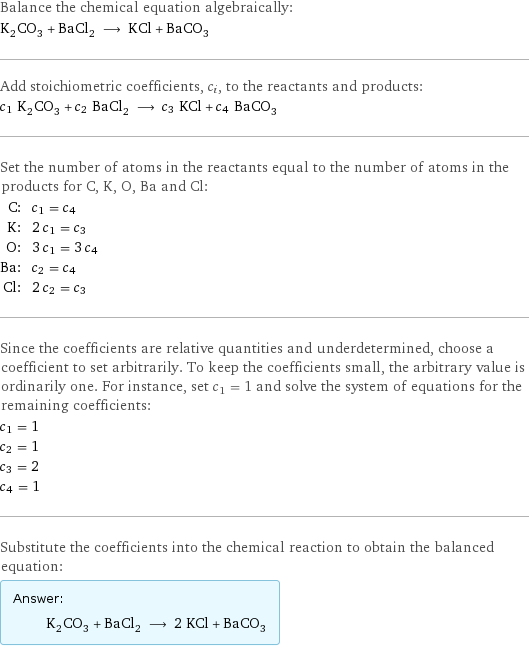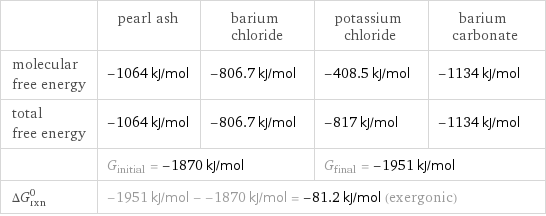Input interpretation

K_2CO_3 pearl ash + BaCl_2 barium chloride ⟶ KCl potassium chloride + BaCO_3 barium carbonate
Balanced equation

Balance the chemical equation algebraically: K_2CO_3 + BaCl_2 ⟶ KCl + BaCO_3 Add stoichiometric coefficients, c_i, to the reactants and products: c_1 K_2CO_3 + c_2 BaCl_2 ⟶ c_3 KCl + c_4 BaCO_3 Set the number of atoms in the reactants equal to the number of atoms in the products for C, K, O, Ba and Cl: C: | c_1 = c_4 K: | 2 c_1 = c_3 O: | 3 c_1 = 3 c_4 Ba: | c_2 = c_4 Cl: | 2 c_2 = c_3 Since the coefficients are relative quantities and underdetermined, choose a coefficient to set arbitrarily. To keep the coefficients small, the arbitrary value is ordinarily one. For instance, set c_1 = 1 and solve the system of equations for the remaining coefficients: c_1 = 1 c_2 = 1 c_3 = 2 c_4 = 1 Substitute the coefficients into the chemical reaction to obtain the balanced equation: Answer: | | K_2CO_3 + BaCl_2 ⟶ 2 KCl + BaCO_3
Structures

+ ⟶ +
Names

pearl ash + barium chloride ⟶ potassium chloride + barium carbonate
Reaction thermodynamics
Enthalpy

| pearl ash | barium chloride | potassium chloride | barium carbonate molecular enthalpy | -1151 kJ/mol | -855 kJ/mol | -436.5 kJ/mol | -1213 kJ/mol total enthalpy | -1151 kJ/mol | -855 kJ/mol | -873 kJ/mol | -1213 kJ/mol | H_initial = -2006 kJ/mol | | H_final = -2086 kJ/mol | ΔH_rxn^0 | -2086 kJ/mol - -2006 kJ/mol = -80 kJ/mol (exothermic) | | |
Gibbs free energy

| pearl ash | barium chloride | potassium chloride | barium carbonate molecular free energy | -1064 kJ/mol | -806.7 kJ/mol | -408.5 kJ/mol | -1134 kJ/mol total free energy | -1064 kJ/mol | -806.7 kJ/mol | -817 kJ/mol | -1134 kJ/mol | G_initial = -1870 kJ/mol | | G_final = -1951 kJ/mol | ΔG_rxn^0 | -1951 kJ/mol - -1870 kJ/mol = -81.2 kJ/mol (exergonic) | | |
Equilibrium constant
![Construct the equilibrium constant, K, expression for: K_2CO_3 + BaCl_2 ⟶ KCl + BaCO_3 Plan: • Balance the chemical equation. • Determine the stoichiometric numbers. • Assemble the activity expression for each chemical species. • Use the activity expressions to build the equilibrium constant expression. Write the balanced chemical equation: K_2CO_3 + BaCl_2 ⟶ 2 KCl + BaCO_3 Assign stoichiometric numbers, ν_i, using the stoichiometric coefficients, c_i, from the balanced chemical equation in the following manner: ν_i = -c_i for reactants and ν_i = c_i for products: chemical species | c_i | ν_i K_2CO_3 | 1 | -1 BaCl_2 | 1 | -1 KCl | 2 | 2 BaCO_3 | 1 | 1 Assemble the activity expressions accounting for the state of matter and ν_i: chemical species | c_i | ν_i | activity expression K_2CO_3 | 1 | -1 | ([K2CO3])^(-1) BaCl_2 | 1 | -1 | ([BaCl2])^(-1) KCl | 2 | 2 | ([KCl])^2 BaCO_3 | 1 | 1 | [BaCO3] The equilibrium constant symbol in the concentration basis is: K_c Mulitply the activity expressions to arrive at the K_c expression: Answer: | | K_c = ([K2CO3])^(-1) ([BaCl2])^(-1) ([KCl])^2 [BaCO3] = (([KCl])^2 [BaCO3])/([K2CO3] [BaCl2])](../image_source/e2d8e2524f00881b76c6138807344fc6.png)
Construct the equilibrium constant, K, expression for: K_2CO_3 + BaCl_2 ⟶ KCl + BaCO_3 Plan: • Balance the chemical equation. • Determine the stoichiometric numbers. • Assemble the activity expression for each chemical species. • Use the activity expressions to build the equilibrium constant expression. Write the balanced chemical equation: K_2CO_3 + BaCl_2 ⟶ 2 KCl + BaCO_3 Assign stoichiometric numbers, ν_i, using the stoichiometric coefficients, c_i, from the balanced chemical equation in the following manner: ν_i = -c_i for reactants and ν_i = c_i for products: chemical species | c_i | ν_i K_2CO_3 | 1 | -1 BaCl_2 | 1 | -1 KCl | 2 | 2 BaCO_3 | 1 | 1 Assemble the activity expressions accounting for the state of matter and ν_i: chemical species | c_i | ν_i | activity expression K_2CO_3 | 1 | -1 | ([K2CO3])^(-1) BaCl_2 | 1 | -1 | ([BaCl2])^(-1) KCl | 2 | 2 | ([KCl])^2 BaCO_3 | 1 | 1 | [BaCO3] The equilibrium constant symbol in the concentration basis is: K_c Mulitply the activity expressions to arrive at the K_c expression: Answer: | | K_c = ([K2CO3])^(-1) ([BaCl2])^(-1) ([KCl])^2 [BaCO3] = (([KCl])^2 [BaCO3])/([K2CO3] [BaCl2])
Rate of reaction
![Construct the rate of reaction expression for: K_2CO_3 + BaCl_2 ⟶ KCl + BaCO_3 Plan: • Balance the chemical equation. • Determine the stoichiometric numbers. • Assemble the rate term for each chemical species. • Write the rate of reaction expression. Write the balanced chemical equation: K_2CO_3 + BaCl_2 ⟶ 2 KCl + BaCO_3 Assign stoichiometric numbers, ν_i, using the stoichiometric coefficients, c_i, from the balanced chemical equation in the following manner: ν_i = -c_i for reactants and ν_i = c_i for products: chemical species | c_i | ν_i K_2CO_3 | 1 | -1 BaCl_2 | 1 | -1 KCl | 2 | 2 BaCO_3 | 1 | 1 The rate term for each chemical species, B_i, is 1/ν_i(Δ[B_i])/(Δt) where [B_i] is the amount concentration and t is time: chemical species | c_i | ν_i | rate term K_2CO_3 | 1 | -1 | -(Δ[K2CO3])/(Δt) BaCl_2 | 1 | -1 | -(Δ[BaCl2])/(Δt) KCl | 2 | 2 | 1/2 (Δ[KCl])/(Δt) BaCO_3 | 1 | 1 | (Δ[BaCO3])/(Δt) (for infinitesimal rate of change, replace Δ with d) Set the rate terms equal to each other to arrive at the rate expression: Answer: | | rate = -(Δ[K2CO3])/(Δt) = -(Δ[BaCl2])/(Δt) = 1/2 (Δ[KCl])/(Δt) = (Δ[BaCO3])/(Δt) (assuming constant volume and no accumulation of intermediates or side products)](../image_source/af641327ce78c0bc314fbb9284021caa.png)
Construct the rate of reaction expression for: K_2CO_3 + BaCl_2 ⟶ KCl + BaCO_3 Plan: • Balance the chemical equation. • Determine the stoichiometric numbers. • Assemble the rate term for each chemical species. • Write the rate of reaction expression. Write the balanced chemical equation: K_2CO_3 + BaCl_2 ⟶ 2 KCl + BaCO_3 Assign stoichiometric numbers, ν_i, using the stoichiometric coefficients, c_i, from the balanced chemical equation in the following manner: ν_i = -c_i for reactants and ν_i = c_i for products: chemical species | c_i | ν_i K_2CO_3 | 1 | -1 BaCl_2 | 1 | -1 KCl | 2 | 2 BaCO_3 | 1 | 1 The rate term for each chemical species, B_i, is 1/ν_i(Δ[B_i])/(Δt) where [B_i] is the amount concentration and t is time: chemical species | c_i | ν_i | rate term K_2CO_3 | 1 | -1 | -(Δ[K2CO3])/(Δt) BaCl_2 | 1 | -1 | -(Δ[BaCl2])/(Δt) KCl | 2 | 2 | 1/2 (Δ[KCl])/(Δt) BaCO_3 | 1 | 1 | (Δ[BaCO3])/(Δt) (for infinitesimal rate of change, replace Δ with d) Set the rate terms equal to each other to arrive at the rate expression: Answer: | | rate = -(Δ[K2CO3])/(Δt) = -(Δ[BaCl2])/(Δt) = 1/2 (Δ[KCl])/(Δt) = (Δ[BaCO3])/(Δt) (assuming constant volume and no accumulation of intermediates or side products)
Chemical names and formulas

| pearl ash | barium chloride | potassium chloride | barium carbonate formula | K_2CO_3 | BaCl_2 | KCl | BaCO_3 Hill formula | CK_2O_3 | BaCl_2 | ClK | CBaO_3 name | pearl ash | barium chloride | potassium chloride | barium carbonate IUPAC name | dipotassium carbonate | barium(+2) cation dichloride | potassium chloride | barium(+2) cation carbonate
Substance properties

| pearl ash | barium chloride | potassium chloride | barium carbonate molar mass | 138.2 g/mol | 208.2 g/mol | 74.55 g/mol | 197.33 g/mol phase | solid (at STP) | solid (at STP) | solid (at STP) | solid (at STP) melting point | 891 °C | 963 °C | 770 °C | 1350 °C boiling point | | | 1420 °C | density | 2.43 g/cm^3 | 3.856 g/cm^3 | 1.98 g/cm^3 | 3.89 g/cm^3 solubility in water | soluble | | soluble | insoluble odor | | odorless | odorless | odorless
Units
